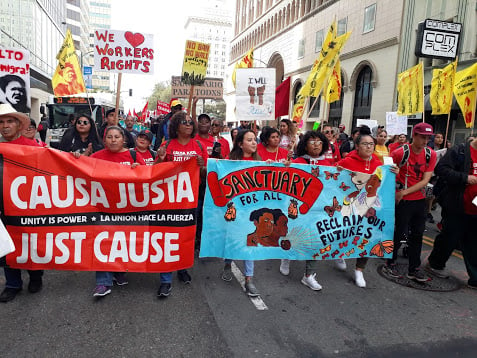Two recently published landscape assessments provide a lot to useful information and provocative analysis that can spur deeper strategic thinking on the left. The first – Mapping the Resistance: Insurgence and Polarization between 2016 and 2020 by Ethan Young – offers both a “political anatomy” of the large and diverse array of anti-Trump organizations and movements as well as a deep dive into the political problems facing its left wing. The second – Carl Davison’s newest update of his U.S. Six-Party System framework – offers a step-back portrait of the main political and economic forces contending for influence in national politics designed to inform radical strategies for the current moment and what may come next.
Mapping the resistance
Mapping the Resistance is one of a series of free pamphlets published by the Rosa Luxemburg Stiftung New York Office. Among others in the series are Trump and American Decline by Vijay Prashad; Learn to Love the Bomb by Christine Hong; Bernie Sanders’ Socialist America by Ethan Earle, and most recently The Far Right in Government by Stefanie Ehmsen and Arthur Scharenberg.
The introduction to Mapping the Resistance by the Rosa Luxemburg Stiftung Co-Directors states the challenge it addresses:
“…we have to overcome the competition and fragmentation that exists among the political groups that are opposed to Trump. Only then is a new united front – outside of or beyond the political mold of twentieth century socialism – possible. Only once democratic political power has been defended against the onslaught of right-wing populism and neoliberalism and we move toward the task of creating a new politics based on equality, justice and solidarity.”
Rich in detail and providing extensive references to first-hand accounts of various facets of the resistance, Young’s pamphlet profiles specific actions (The Women’s March, Medicare for all Campaigns) and key battlefronts (income inequality; unrestricted police violence and militarization; attacks on immigrants and nine more). It covers the increased support for socialism, looking in particular at the growth of Democratic Socialists of America, and highlights the significance of the mayoral electoral victories by Chokwe Lumumba and then his son Chokwe Antar Lumumba in Jackson Mississippi.
The pamphlet is blunt about the problems facing US. radicalism, for example:
“The view from here and now exposes the blind spots of the last two centuries: failure to recognize enslaved Africans (and women keeping house, for that matter) as part of what the traditional socialist movement understood as “the working class.” Taking on why that was, and too often still shapes the views of many in the left, is essential…”
A prominent theme in Young’s essay is the nagging disconnect between “social movements” and “the political Left” as well as fragmentation within the political Left itself. Much of his concluding section focuses on the urgency of tackling that problem both by “politicizing social movements” and building unity within the left:
“The twenty-first century has not provided us with a revolutionary situation, but it demands revolutionary solutions. The capitalist class has taken the species to the brink. The ultimate response is not military or ideological, but political: democratic assertion of democratic power, by any means available… Seeing this political project through is the task of the 21st century united front….
“The political Left, whether operating in socialist formations or within social movement groups, has a particular responsibility to take on the fragmentation of the broader Left. This means reaching across old boundaries…in light of the overarching threat from the consolidation of right/far-right hegemony…
“…the situation demands a transformation of social movements to become consciously political, taking on electoral politics to win the political space needed for all parts of the Left to reach more and more working people.”
The U.S. six-party system
The U.S. Six-Party System 3.0 is the third version of a hypothesis first put forward by Carl Davidson in 2014. Motivating the effort is Davidson’s argument that “the traditional ‘two-party system’ frame obscures more than it reveals” about the actual political and economic forces shaping current battles and events. He writes that “U.S. major parties, in general, are not ideological parties in the European sense, but constantly changing coalitions of [factional or interest-group] clusters with no firm commitment to program or discipline.” Uncovering the nature, interests and relative strength of these groupings (whether called clusters, parties, factions or some other term) – and drawing out the strategic implications for the left – is the purpose of influence.
The essay argues that three main parties operate under the umbrella of today’s Republican Party. The first is the “Rightwing Populists” who have grown substantially in the wake of Trump’s 2016 electoral campaign and subsequent victory. Both branded with and driven by “America First” [white] nationalism, the essay highlights the deep roots of this outlook in U.S. history, “from the anti-Indian ethnic cleansing of President Andrew Jackson to the nativism of the Know-Nothings to the lynch terror of the KKK to the anti-elitism of George Wallace and the Dixiecrats.
Trump’s Rightwing Populists have forged a close alliance with the second party within the GOP, the Christian Nationalists. The alliance was solidified with the selection of Mike Pence as Trump’s vice-president. Together, these two factions, backed by right-wing billionaires like the Kochs and Mercers and with Fox News as their mouthpiece, have taken leadership of the GOP away from the “Establishment Neoliberals” who had previously owned and run the GOP for years. The fight within the GOP is ongoing, and Davidson’s essay speculates that “the November mid-terms will bring to light the new balance.”
Davidson identifies three different clusters as operating under the Democratic tent. The weakest are semi-populist “Blue Dogs” who are prepared to cut deals with Trump especially on economic issues and who have (unstable) support in several unions. Still dominating the Democratic Party leadership are the “Third Way New Democrats” founded by the Clintons. This faction is funded by Wall Street finance capitalists and has aimed to “shift the key social base from the working class to college-educated suburban voters” (while trying to keep alliances with Black and women’s groups “still functional”). The defeat of Hilary Clinton in 2016 has weakened this group’s hold on power within the Democratic Party.
Broadly ranged against these is the party this essay terms “Social Democrats.” Explaining the term, Davidson writes that “it doesn’t mean each leader active here is in a social-democratic group. It means the core of the Congressional Black Caucus, Progressive Democrats of America, Working Families Party and Our Revolution platforms are roughly similar to the left social democrat groupings in Europe.” He adds that “This made even more evident with Bernie’s self-description as a ‘democratic socialist’…It must be noted, however, that the platform is not socialism itself, but best described as a common front vs. finance capital, war and the white supremacist right.”
Wrapping up the essay, Davidson argues that identifying these forces illuminates the battles taking place within the GOP, within the Democratic Party, and between the two parties, and also sheds light on what’s behind current budget debates. Strategically, the essay argues for “pushing the popular front vs. finance capital to its limits, and within that effort, developing a 21st century socialist bloc” while adding two important points that apply even more generally to left work: “If you don’t have a strategy, you’re part of someone else’s strategy” and “You rarely gain victories at the top that have not been won and consolidated earlier at the base.”
The U.S. Six-Party System can be found here and Mapping the Resistance here.
Resources compiled by Max Elbaum; Max is an editor of Organizing Upgrade

